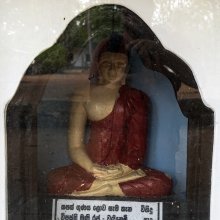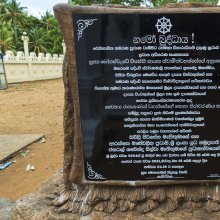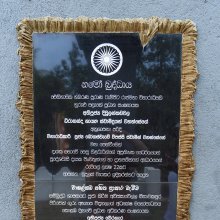Vipassi, Vipassī: 3 definitions
Introduction:
Vipassi means something in Buddhism, Pali, Jainism, Prakrit. If you want to know the exact meaning, history, etymology or English translation of this term then check out the descriptions on this page. Add your comment or reference to a book if you want to contribute to this summary article.
Images (photo gallery)
In Buddhism
Theravada (major branch of Buddhism)
Source: Pali Kanon: Pali Proper NamesThe nineteenth of the twenty four Buddhas. He was born in the Khema park in Bandhumati, his father being Bandhuma and his mother Bandhumati. He belonged to the Kondanna gotta. For eight thousand years he lived as a householder in three palaces: Nanda, Sunanda and Sirima. His body was eighty cubits in height. His wife was Sutana (v.l. Sudassana) and his son Samavattakkhandha. He left the household in a chariot and practised austerities for eight months. Just before his enlightenment, the daughter of Sudassana setthi gave him milk rice, while a yavapalaka named Sujata gave grass for his seat. His bodhi was a patali tree. He preached his first sermon in Khemamigadaya to his step brother Khandha and his purohitas son Tissa; these two later became his chief disciples. His constant attendant was Asoka; Canda and Candamitta were his chief women disciples. His chief lay patrons were Punabbasummitta and Naga among men, and Sirima and Uttara among women. He died in Sumittarama at the age of eighty thousand, and his relics were enshrined in a thupa seven leagues in height. The Bodhisatta was a Naga king named Atula. (Bu.xx.1ff.; BuA.195f.; D.ii.2ff).
Three reasons are given for the name of this Buddha (BuA.195; cf. DA.ii.454; SA.ii.15): (1) Because he could see as well by night as by day; (2) because he had broad eyes; (3) because he could see clearly after investigation. Vipassi held the uposatha only once in seven years (DhA.iii.236), but on such occasions the whole Sangha was present (Sp.i.186). The construction of a Gandhakuti for Vipassi brought Mendaka great glory in the present age. Mendakas name at the time was Avaroja (DhA.iii.364f). Annakondanna was then known as Culakala, and nine times he gave Vipassi Buddha the first fruits of his fields. DhA.i.81f.
Theravāda is a major branch of Buddhism having the the Pali canon (tipitaka) as their canonical literature, which includes the vinaya-pitaka (monastic rules), the sutta-pitaka (Buddhist sermons) and the abhidhamma-pitaka (philosophy and psychology).
Languages of India and abroad
Pali-English dictionary
Source: BuddhaSasana: Concise Pali-English Dictionaryvipassi : (aor. of vipassati) saw clearly; had intuition. || vipassī (m.) gifted with insight.

Pali is the language of the Tipiṭaka, which is the sacred canon of Theravāda Buddhism and contains much of the Buddha’s speech. Closeley related to Sanskrit, both languages are used interchangeably between religions.
Prakrit-English dictionary
Source: DDSA: Paia-sadda-mahannavo; a comprehensive Prakrit Hindi dictionaryVipassi (विपस्सि) in the Prakrit language is related to the Sanskrit word: Vidarśin.
Prakrit is an ancient language closely associated with both Pali and Sanskrit. Jain literature is often composed in this language or sub-dialects, such as the Agamas and their commentaries which are written in Ardhamagadhi and Maharashtri Prakrit. The earliest extant texts can be dated to as early as the 4th century BCE although core portions might be older.
See also (Relevant definitions)
Starts with: Vipassi Sutta, Vipassin, Vipassitva.
Full-text (+149): Sumittarama, Vidarshin, Bandhumati, Vipassi Sutta, Candamitta, Samavattakkhandha, Pharusaphaladayaka, Mahanta Parivena, Anusamsavaka, Kukkura, Bodhivandaka, Thomadayaka, Padumakesariya, Ekasankhiya, Udapanadayaka, Vediyadayaka, Paramannadayaka, Suputakapujaka, Ti Kinkinipupphiya, Bhisaluvadayaka.
Relevant text
Search found 18 books and stories containing Vipassi, Vipassī; (plurals include: Vipassis, Vipassīs). You can also click to the full overview containing English textual excerpts. Below are direct links for the most relevant articles:
Apadana commentary (Atthakatha) (by U Lu Pe Win)
Commentary on Biography of the thera Pulinapūjaka < [Chapter 3 - Subhūtivagga (section on Subhūti)]
Commentary on Biography of the thera Paccāgamaniya < [Chapter 7 - Sakacintaniyavagga (section on Sakacintaniya)]
Commentary on Biography of the thera Padumacchādaniya < [Chapter 5 - Upālivagga (section on Upāli)]
The Great Chronicle of Buddhas (by Ven. Mingun Sayadaw)
Buddha Chronicle 19: Vipassī Buddhavaṃsa < [Chapter 9 - The chronicle of twenty-four Buddhas]
Part 2 - The two forms of Pāṭimokkha < [Chapter 16 - The arrival of Upatissa and Kolita]
The Four Avijahitaṭṭhāna (Four Sacred Places) < [Chapter 25 - The Buddha’s Seventh Vassa]
Buddhist Monastic Discipline (by Jotiya Dhirasekera)
Appendix I - The Exclusion of Guilty Monks (from the recital of the patimokkha)
Chapter III - The Early Buddhist Ideal of the Monk
Chapter IV - The Foundations of Monastic Life (sila, sikkha and sikkhapada)
Dhammapada (Illustrated) (by Ven. Weagoda Sarada Maha Thero)
Verse 252 - The Story of Meṇḍaka the Rich Man < [Chapter 18 - Mala Vagga (Impurities)]
Verse 414 - Seven Years in the Womb < [Chapter 26 - Brāhmaṇa Vagga (The Brāhmaṇa)]
Verse 183-185 - The Story of the Question Raised by Venerable Ānanda < [Chapter 14 - Buddha Vagga (The Buddha)]
Maha Prajnaparamita Sastra (by Gelongma Karma Migme Chödrön)
I. Apparent longevity of the buddhas < [Part 16 - Obtaining the immense longevity and immense radiance of the Buddhas]
Act 9.2: Examination of the plurality of Buddha < [Chapter XV - The Arrival of the Bodhisattvas of the Ten Directions]
Maha Kassapa (by Hellmuth Hecker)



